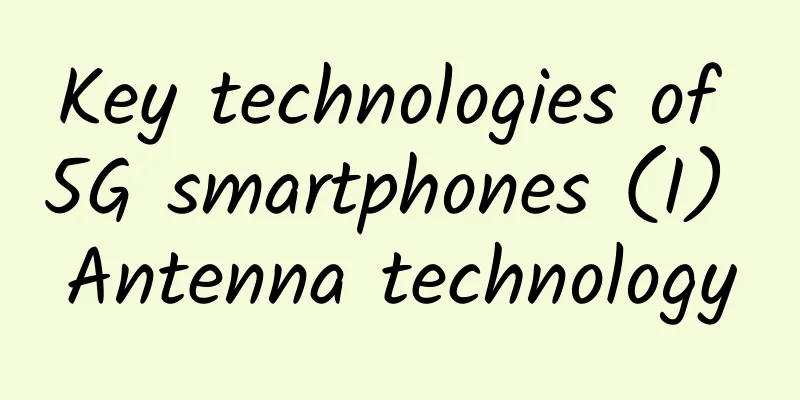Key technologies of 5G smartphones (I) Antenna technology

Labs Guide5G smartphones involve the technological upgrade of the entire industry chain. What is the difference between them and 4G smartphones? Which technologies will play a key role in the popularization of 5G smartphones? Let's talk about the key component technology of 5G smartphones (I) - antenna.
1. What is a mobile phone made of?Generally speaking, mobile phones can be roughly divided into two types. One is feature phones, which basically only have the functions of making calls and sending color text messages. For example, Nokia and Motorola were the dominant brands in the feature phone era, but now they only appear in specific fields or in the form of elderly phones. The other is smart phones, which have become more common since the birth of the iPhone, represented by iPhone, Samsung, Xiaomi, and OPPO. With the continuous development of communication technology, mobile phones have evolved from carrying simple functions to supporting rich media such as voice, data, music, and video. At the same time, they can expand and install a variety of applications to meet people's various needs. To make it easier for everyone to understand, we have made a simplified and abstract diagram. As shown below, a smartphone that can support making calls, sending text messages, various Internet services and various APP applications should usually include at least six parts: antenna, radio frequency, baseband and application processor, software, peripherals and power management. The figure below is the most basic principle diagram, which can be said to be indispensable. Based on this, we will further introduce them one by one. Due to space limitations, this article will first focus on the antenna part. 2. Do current smartphones still need antennas?An antenna is a device used to transmit or receive radio waves. Its function is to complete the radiation and reception of electromagnetic waves through the mutual conversion of electric field and magnetic field under the basic principle of electromagnetic field. The specific process is to convert the circuit signal energy output by the transmitter into electromagnetic waves for radiation, or to convert the electromagnetic wave signal in space into circuit signal energy and send it to the receiver. In other words, to put it in a more understandable way, the work of the antenna is to complete the transmission and reception of what we often call signals. Generally speaking, an antenna is a wire of a specified length, which is usually 1/4 to 1/2 of the wavelength. Therefore, the higher the propagation frequency, the shorter the antenna. Mobile communication networks have evolved from the initial 1G/2G to today's 4G/5G systems, and the communication frequencies supported by mobile phones have gradually reached the GHz band. As a result, the size of mobile phone antennas has also changed from large to small, and from external to internal. At the same time, terminals have also evolved from the era of feature phones to the era of smartphones, and the manufacturing process of mobile phones is constantly improving. Consumers are also paying more and more attention to factors such as the appearance and cost of mobile phone products. Mobile phones are constantly developing in the direction of miniaturization, intelligence, lightness, and narrow bezels. 3. What is the most basic measurement indicator of antenna?The design of antennas is often affected by factors such as the shape, structure, circuit board layout, and metal parts of mobile phones, and the difficulty of development is increasing. The design of mobile phone antennas is no longer a local issue, but has long become an important part of mobile phone system design. It is necessary not only to fully consider the antenna type, feeding method, and placement of the antenna in the device, but also to take into account technical requirements such as wide frequency band, high efficiency, low SAR value, and isolation. Not only do the basic RF performance indicators of the antenna need to be met, including directivity, impedance, polarization, standing wave ratio, return loss, gain, efficiency, etc., but also the requirements of the RF performance indicators of the entire mobile terminal product need to be met. For example, the main test indicators closely related to mobile phone antennas include OTA test indicators, SAR test indicators, and EMC test indicators. Note:
4. Types of mobile phone antennas and difficulties and challenges encountered in designCurrently, the common designs of mobile phone antennas are mainly based on three methods: shell injection molding, metal bracket and FPC antenna. In particular, the metal shell of the iPhone is a representative example. The antenna is gradually injected into the metal shell, and a small amount of metal bracket antenna is used inside the phone. With the evolution of 2G/3G/4G/5G mobile communication technology and the coexistence of multiple networks, smart phones and extended applications continue to emerge, and the number of communication bands and wireless connection methods that need to be supported is increasing. In particular, high-end flagship mobile phones need to support at least more than 40 communication bands in order to travel around the world. What's more serious is that the number of antennas in smart phones is increasing, and the concept of mobile phone antennas is not limited to mobile communications. Increasingly thin and light sizes need to accommodate and support more and more antennas, such as Wi-Fi antennas, Bluetooth antennas, GPS antennas, NFC antennas and other wireless connection methods. Even the increasingly popular wireless charging uses a charging coil, which is also an antenna. The number of frequency bands and the number of types that mobile phone antennas need to support are also increasing, and the design challenge is becoming more and more difficult. Another challenge comes from the screen. One of the continuous innovations of smartphones in recent years has been to increase the screen-to-body ratio. Manufacturers have begun to launch thinner, borderless screens and full-screen phones with an 18:9 screen aspect ratio. Because the antenna must be placed outside the screen area, the area available for antenna design is reduced by more than 50%. At the same time, the width of the borders at the top and bottom of the screen is reduced to 3-4 mm. Due to the change in the screen aspect ratio, the phone has also become narrower. These changes mean that the phone antenna must be shorter, which in turn affects performance. The reduction in antenna area and length will directly affect performance and efficiency. Its transmission and reception performance will inevitably be affected, and it will also bring various disadvantages, including shortened battery life, smaller radiation range, lower rate, etc. At present, the frequency band of 4G communication is 2.6GHz, and the communication frequency band used by the main 5G is also below 6GHz. Therefore, the current support for 5G low-frequency Sub-6 band will not have a significant change in the size of the mobile phone antenna compared with 4G, mostly changes in the number of antenna combinations. For example, 4G mobile phones generally require 4-6 antennas, and 5G mobile phones generally have more than 10 antennas. Taking Huawei Mate30 as an example, the mobile phone antenna has as many as 21 antennas. Of course, it is not like Huawei's Yu Chengdong always said that these 21 antennas are used for 5G. As mentioned above, here are 2 for GPS, 2 for Wi-Fi 2.4G, 2 for Wi-Fi 5G, and 1 for NFC. In addition, the other 14 are real mobile communication antennas that support 5G, 4G and a series of communication standards. 5. How to view the trend of mobile phone antenna design in the futureAs the internal space of mobile phones becomes more compact, it is difficult to find a flat surface for antenna design. At present, in order to control costs, some mid- and low-end mobile phones still use a large number of FPC (flexible circuit board, which can be understood as an antenna similar to the style of mobile phone wiring) antennas. However, the processing accuracy and bonding process of FPC make the signal quality unstable. However, its advantages should not be ignored. That is, FPC antennas can be folded and bent into any shape, which can meet people's higher requirements for the size and design of portable devices. Therefore, in order to give full play to its advantages while avoiding some of its disadvantages, the industry has gradually introduced FPC antennas made of LCP material with good high-frequency characteristics and paid attention to them. As 5G has higher requirements for antenna accuracy and reliability, LDS (Laser-Direct-structuring) antenna technology has become the preferred solution for mobile phone antenna design. LDS technology uses laser to directly plate a metal antenna shape on a molded plastic bracket. This technology avoids electromagnetic interference from internal components of the mobile phone, ensures the signal of the mobile phone, and also enhances the space utilization of the mobile phone, so that smartphones can still maintain a certain degree of slimness in the 5G era. Compared with the current Sub-6GHz 5G frequency band or the upcoming 700M 5G frequency band, the future commercial introduction of 5G millimeter waves will be a great challenge to mobile phone antenna design. The reason why 5G millimeter waves are called millimeter waves is that the frequency of tens of GHz has reduced its wavelength to the millimeter level. The problem caused by the significant reduction in wavelength is that the diffraction ability of electromagnetic waves becomes poor, and the attenuation becomes extremely obvious. To improve the attenuation problem caused by high frequencies, MIMO multi-antennas and beamforming can be used to solve the problem from the perspective of spatial propagation. However, in order to ensure the integrity of the signal inside the mobile phone, the RF front end needs to be as close to the millimeter wave antenna as possible. The small size of the millimeter wave antenna makes it possible to co-package the antenna and RF front end, transceiver and other devices. The narrow chip shape makes it easy to embed directly into the mobile phone frame. As shown above, Qualcomm's latest millimeter wave antenna module contains an ultra-small phased antenna array. The antenna module supports beamforming, control and tracking, which greatly improves the transmission range and reliability of millimeter wave signals. Of course, compared with the non-standardized antennas in the past, the standardization of millimeter wave antenna modules will bring many conveniences, but they still face the challenge of layout in the small space inside the mobile phone. The design of 5G mobile phone antennas is more difficult than in the past. Not only must the wireless technology itself be considered, but also compatibility with systems such as batteries, cameras, speakers, displays, fingerprint recognition chips, wireless charging collars, etc., while also effectively solving the problem of multi-antenna layout in a small space. From the above, we can see that although the antenna is usually inconspicuous, its design and performance are directly related to the product experience of the mobile phone. To be continued... [This article is an original article by 51CTO columnist "Mobile Labs". Please contact the original author for reprinting.] Click here to read more articles by this author |
Recommend
Computer pop-up ads are too annoying, teach you how to completely solve them
So, how can you completely remove these annoying ...
Will OPPO and vivo, which have invested in chip companies, get involved in independent mobile phone chips?
Driven by industry giants such as Huawei, Samsung...
People with weak spleen and stomach cannot hide their face! These 4 symptoms need to be treated in time
Mr. Zhang, 45 years old, has been feeling stomach...
What do ROI, CPA, CPC, and OCPM mean in SEM promotion?
In every industry, there are unique professional ...
How to promote and operate APP in 2019?
What is the correct way to promote APP? What shou...
Tesla CEO Musk announced that the core code of Autopilot has been rewritten and will bring a lot of updates
Recently, in an interview with foreign media, Tes...
Build a user growth activity matrix in 3 steps
The online education industry has achieved rapid ...
Anniversary event planning: 5 steps from planning to implementation!
The growth of a person needs the blessing of birt...
Analysis of product life cycle model!
How do you view the product life cycle ? Insights...
How to maximize the effectiveness of video, information flow and other platforms?
Today’s article is about: Marketing strategies fo...
How does the training camp achieve an overall conversion rate of 81%?
I believe you must have seen various training cam...
Behind NetQin's success in mobile entertainment: three magic weapons for successful transformation
Ten years ago, NetQin entered the security field ...
Soaking the server in water turns out to be for... | Digital Literacy
Audit expert: Zheng Yuanpan Professor of Zhengzho...
DeepSeek's new app! What these post-90s people in Hangzhou did became a hot topic
Dongpo pork, stir-fried vegetables with mushrooms...
Chang'e 6 returns from "digging soil"! Who is on the back of the moon?
At 14:07 on June 25, the Chang'e-6 returner c...









